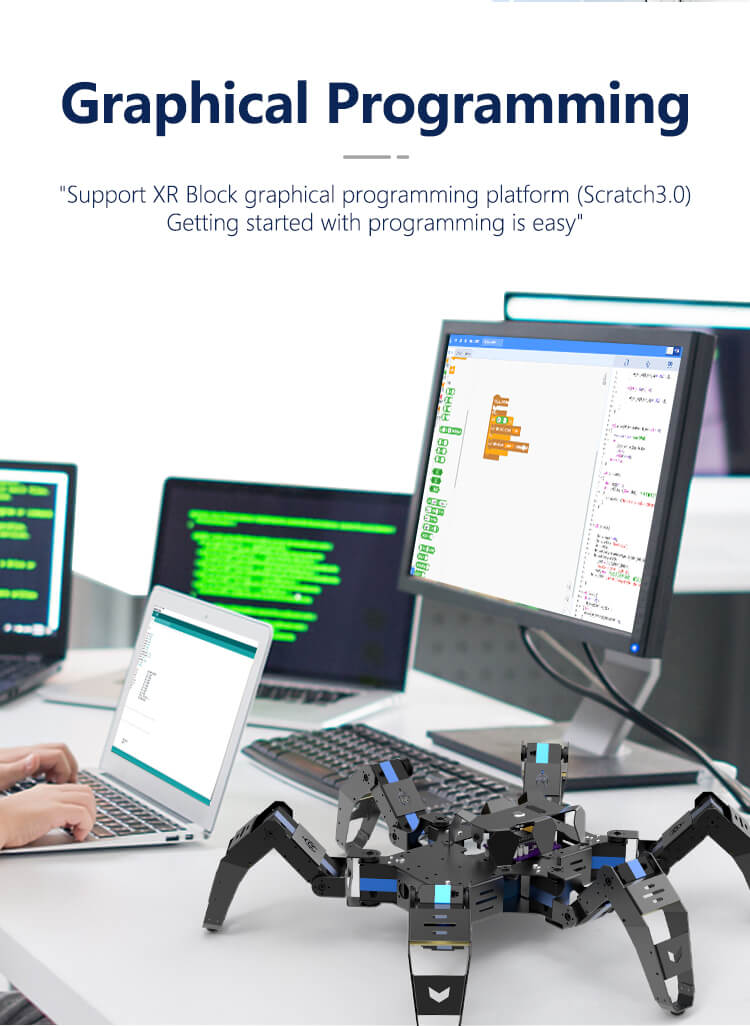With the continuous development of modern technology, robotics technology has penetrated into various fields. Bionic robots have also become one of them. By imitating the structure, movement gait and functions of living organisms, they have extremely high practical value. This article will focus on the design concepts, implementation methods and application scenarios of hexapod bionic robots.
1. Design concept
Hexapod bionic robots raspberry pi imitate the six-legged walking method of insects and have very good stability and terrain adaptability. Its design concept is based on multiple disciplines such as biology, mechanics and cybernetics, aiming to create an efficient and reliable robot platform that can perform stable movement in complex environments.
2. Implementation method
Mechanical structure: The mechanical structure of the hexapod bionic robot consists of six legs and the main body. Each leg contains 3 joints and uses 35KG metal gear servos. There are 18 servos in the whole body, plus a 2-degree-of-freedom camera, a total of 20 servos, which can more realistically simulate the six-legged creatures in nature. Gait function, etc. to adapt to different terrains and environments. In addition, interfaces are reserved on the main body of the robot, and various sensors and control modules can be installed to realize the robot's autonomous movement and environmental perception.
Control system: The core of the control system is a microprocessor. You can choose Jetson Nano or Raspberry Pi as the main control board according to your personal application habits. It is responsible for receiving signals from various sensors and controlling the movement of each leg according to the preset algorithm. . By adjusting the movement speed and angle of each leg, the robot can move forward, backward, turn left, turn right, translate left, translate right, raise its legs and other actions.
Sensors: In order to realize autonomous movement of the robot, various sensors need to be used to sense the environment. Commonly used sensors include infrared sensors, ultrasonic sensors and collision sensors. These sensors can sense information about the surrounding environment and feed the information back to the control system so that the robot can take corresponding actions.
3. Application scenarios
Exploration and rescue: Hexapod bionic Jetson Nano robots can perform exploration and rescue work in complex environments. For example, searching for people trapped in the rubble after an earthquake, or conducting environmental monitoring in hazardous areas.
Agricultural applications: Hexapod bionic robots can be used in the agricultural field to perform farmland patrols, plant protection and harvesting. This robot has excellent terrain adaptability and stability, and can operate efficiently in different soil and terrain conditions.
Scientific research: Hexapod bionic robots can also be used in scientific research, such as biology, ecology, geology and other fields. By imitating the six-legged walking style of insects, the robot can conduct long-term observations and data collection in complex environments.
Educational field: Hexapod bionic robots can also be used as educational tools to help students understand biology, mechanics and cybernetics. This kind of robot is intuitive and operable, and can stimulate students' learning interest and creativity.
Terrain exploration: The excellent terrain adaptability and stability of the hexapod bionic robot give it great potential in the field of terrain exploration. It can be sent to various complex terrains, such as swamps, deserts, forests, etc., to conduct geological surveys, resource exploration or environmental monitoring.
Logistics and transportation: In areas where conventional transportation is not available, such as mountainous areas, swamps or remote areas, six-legged bionic robots can be used as efficient logistics and transportation tools. It can stably traverse complex terrain and provide necessary material transportation services in these areas.
Deep-sea exploration: In the deep-sea environment, it is difficult for humans to operate directly due to the pressure and the particularity of the environment. Hexapod bionic robots can replace humans in deep-sea exploration and resource development, helping us gain an in-depth understanding of deep-sea ecosystems while also developing mineral resources.
Space Exploration: In the gravity-free space environment, the stability and flexibility of hexapods make them ideal for space exploration. For example, in exploration missions on the surfaces of planets such as Mars, hexapod robots can replace humans in surface surveying and sample collection.
Entertainment industry: Hexapod bionic robots can also be used in the entertainment industry, such as theme parks, film production, etc. By combining virtual reality and augmented reality technologies, novel entertainment experiences can be created to attract more tourists and audiences.
Disaster rescue: After earthquakes, fires and other disasters occur, six-legged bionic robots can enter dangerous areas and search for trapped people, providing valuable time for rescue efforts. At the same time, it can also be used to transport relief supplies and facilitate rescue work.
Sports training: In sports training, six-legged bionic robots can help athletes perform high-intensity and efficient physical training and improve their performance. For example, in rock climbing, mountaineering and other sports, hexapod robots can simulate various complex terrains and provide athletes with a realistic training environment.
Medical care: Hexapod bionic robots can also be used in the field of medical care. For example, in rehabilitation treatment, this kind of robot can help patients carry out limb rehabilitation training and improve the rehabilitation effect. In institutions such as nursing homes, six-legged robots can help caregivers complete some simple care tasks and reduce their burden.
In short, as a new type of robot technology, hexapod bionic robot has broad application prospects and market potential. Through continuous technological innovation and market expansion, it is believed that this kind of robot will play a greater role in the future and bring more convenience and development to human society.

